Mac Musings
Today's Macs: Many Descendants from a Common Ancestor
Daniel Knight - 2009.01.27 -
There's a fundamental difference between the way Apple and Dell do business.
The PC Way
Dell and most PC makers have a simple strategy: Give customers more models than they can keep track of, more options than you can shake a stick at, keep inventories and overhead low, aim for price conscious customers, sell the base model cheap but spec it out so almost everyone buys profitable upgrades, don't worry about which ones sell, and make your money from volume.
It's a common pattern in American business, one that auto industry has used for decades to keep a range of brands alive that sell essentially the same car with different option packages - Ford Taurus vs. Mercury Sable, Chevy Camaro vs. Pontiac Firebird, and sometimes the same car would be branded a Chevy, Pontiac, Buick, Olds, and Cadillac. And then there were the different versions, such as SES and SEL - whatever those mean.
In the end, there were more models than anyone could keep track of, more option packages and individual options than you could shake a stick at, huge inventories and high overhead, strong price competition at the low end, cheap base models that almost everyone added profitable upgrades to, and dealers and manufacturers who had to earn a profit from volume, not individual sales.
We know where that's taken the American auto industry - to the brink of bankruptcy. And lots of PC makers have gone bankrupt or reached the point where someone else bought them out for a song: Northgate, Zenith, Leading Edge, Gateway, and Compaq come to mind.
The Apple Way
Apple has generally had a different strategy: Give customers a somewhat limited range of models, a few build-to-order options, maintain inventories and invest in design, aim for quality conscious customers, sell base models that really are adequate while offering profitable upgrades, worry about how each model will impact the others, and make your money on every purchase.
Apple's profit margin is the highest in the industry, and it deserves those profits. Because of those profit margins, Apple can take chances on an MP3 player, a mobile phone, or Apple TV. Apple provides a unique user experience that nobody can clone - Windows is not the Mac OS, no other smartphone is an iPhone, and no other MP3 player is an iPod.
It's not about features. Windows has some capabilities that Mac OS X doesn't. Some smartphones have better features than the iPhone. Some MP3 players do things no iPod does. And there are several DVR alternatives to Apple TV, which isn't a DVR and doesn't yet have a clearly determined niche, yet it remains on the market.
Macs are a minority platform, but the Mac market share is growing year after year. The iPod started slowly as a Mac-only device, became a FireWire-only device for Macs or Windows, and grew to dominate the MP3 player market after embracing USB 2.0, while Microsoft's Zune is fading fast. The iPhone, just 18 months out of the gate, is the most important smartphone on the market and could come to dominate if BlackBerry stumbles.
A Clash of Cultures
The PC market is commodity based and consumer driven. Whether you buy a Dell, HP, Acer, Sony, or locally built machine, the user experience will be essentially the same - the same operating system (whether Windows or Linux), the same applications, almost the same level of processing power and graphics power, the same brands of hard drives and optical drives inside, etc.
For the most part, when you buy a PC, you choose what CPU, CPU speed, graphics processor, amount of RAM, hard drive size, and display you want. If you buy from a store, the staff will do its best to up-sell you - more RAM, a faster CPU, a bigger display, a faster disc burner, etc.
Apple really does think different. If you want an iPhone, you have two meaningful choices: 8 GB or 16 GB of storage. If you choose 16, you can have your iPhone in white or black. It's that simple. Any customization comes from the apps you buy.
In the early days, if you wanted an iPod, you had one choice. Then two. Then three. Then came the iPod mini, the iPod shuffle, the iPod photo, the iPod nano, the iPod video, and the iPod touch - after Apple had established the "classic" iPod. There are really three iPod platforms today: the iPod shuffle with no screen or menus, the video iPods (classic and nano), and the iPod touch, which has most of the features and runs the same version of OS X as the iPhone.
The Macintosh Way
Like the iPod, the Macintosh wasn't an immediate success. The original Macintosh had too little memory to be practical - when Steve Jobs demonstrated the Mac, he used a specially upgraded 512 KB Mac. And even after the Mac 512K shipped, a second floppy drive was almost mandatory.
The All-in-One Legacy
It took time for the Mac to have an established presence, and for the first three years of the Macintosh Era, all Macs looked the same - a compact case with a small footprint, 9" black & white display, and a floppy drive plus a mouse and keyboard. The compact Macs were just small enough and light enough to tote between home and work or school in the days before notebooks.
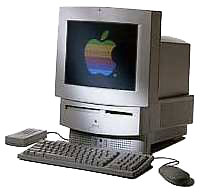
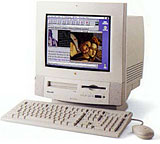
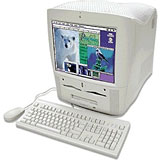
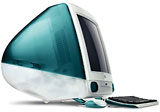
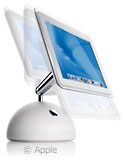
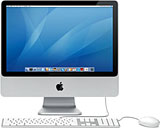
All-in-one desktop Macs from the original Macintosh through the current
iMac.
In early 1993, the compact all-in-one design gained color and an expansion slot with the Color Classic, and later in the year the LC 520 put a CD-ROM drive and 14" color display in a larger integrated Mac. That grew to a 15" multisync monitor with the Performa 5200 in 1995, and the all-in-one Mac reached its maximum weight with the Power Mac G3 All-in-One in 1998 - it was just under 60 lb. (The 50 lb. eMac, produced from 2002 through 2005, holds second spot for weight.)
Jonathan Ive came up with a fresh new look with the original iMac, which was introduced in 1998 in Bondi blue and eliminated the expansion slots that had typified all-in-one Macs since the Color Classic. The iMac design moved to a flat panel display with the 15" iMac G4 in January 2002, seeming to float the display above a hemispherical base. In another complete redesign, the iMac G5 (August 2004) put the entire computer behind the LCD, and that design was updated with glass and aluminum in August 2007.
The Pro Desktop Legacy
Every Macintosh traces its roots to the original design ideas: integrated, portable, expandable (at first only via external devices), and easy to use.
The Mac line first branched in 1987, when Apple added an expandable model with expansion slots, the Mac II. That was the first modular Mac, and the Mac II line split between big 6-slot models and smaller 3-slot Macs in 1989 with the introduction of the Mac IIcx. In 1990, Apple added a modular consumer Mac, the LC, which we'll look at below.
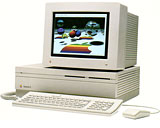
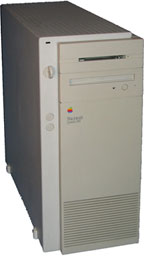
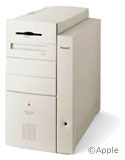
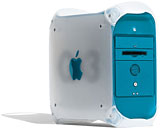


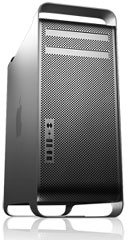
Pro Macintosh computers from the Mac II through the Mac Pro.
We can trace the modular Mac's development on the high end, the low end, and in the middle. The big Mac II models gave way to the Quadra 900 and 950 towers, which begat the Power Mac 9500 and 9600. Over time this line gave us the Blue & White Power Mac G3, an entire range of G4 and G5 Power Macs, and the Mac Pro.
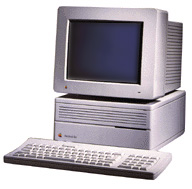
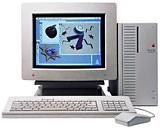
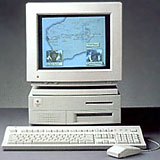
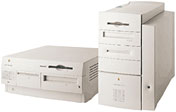
Desktop Macs a step back from the top-end pro models from the Mac IIcx
through the Beige Power Mac G3.
In a more traditional desktop configuration, the IIcx evolved into the mid-sized Quadra 700, which gave way to the Centris 650 desktop and Quadra 800 minitower, the direct ancestors of the Power Mac 7100 and 8100. Over time, these designs became the Beige Power Mac G3, which came in both desktop and minitower configurations. While Apple has had entry-level pro desktops since then, they have been full-sized tower machines.
The Consumer Desktop Legacy: Limited Expansion Slots
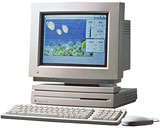 The first low-end Mac
was the Macintosh 512Ke, a
less costly, less featured sibling of the Mac Plus. It gave up SCSI, memory
expansion, and half-a-megabyte of RAM to slash $600 from the $2,600
price of the Plus. The Macintosh LC carried on the legacy of a less
costly, less expandable Mac in 1990. The LC had no NuBus expansion
slots and limited RAM to 10 MB so as not to steal customers from the
Mac II line. For the first time you could buy a Mac with color support
and a color display for under US$3,000.
The first low-end Mac
was the Macintosh 512Ke, a
less costly, less featured sibling of the Mac Plus. It gave up SCSI, memory
expansion, and half-a-megabyte of RAM to slash $600 from the $2,600
price of the Plus. The Macintosh LC carried on the legacy of a less
costly, less expandable Mac in 1990. The LC had no NuBus expansion
slots and limited RAM to 10 MB so as not to steal customers from the
Mac II line. For the first time you could buy a Mac with color support
and a color display for under US$3,000.
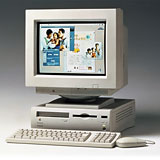 Motherboards from the LC family formed the basis of
the all-in-one Color Classic and LC 500 series mentioned above, and the
small footprint, low profile LC design lasted until 1996, when the
Quadra 605 was discontinued. The
new consumer desktop was the Performa 630 (right), introduced in
1994, which was a bit taller, had a few more expansion options, and
included space for a built-in CD-ROM drive. This design lasted into the
PowerPC era, where it became the basis for the Performa 6200 and 6360, which was the last Mac to use that
case and the only one with a standard expansion slot (PCI).
Motherboards from the LC family formed the basis of
the all-in-one Color Classic and LC 500 series mentioned above, and the
small footprint, low profile LC design lasted until 1996, when the
Quadra 605 was discontinued. The
new consumer desktop was the Performa 630 (right), introduced in
1994, which was a bit taller, had a few more expansion options, and
included space for a built-in CD-ROM drive. This design lasted into the
PowerPC era, where it became the basis for the Performa 6200 and 6360, which was the last Mac to use that
case and the only one with a standard expansion slot (PCI).

Between the big modular Macs and the low-end consumer models, Apple had
another tier of desktop Macs with a bit more expandability - but not
enough to threaten the "pro" models. In fact, may were deliberately
scaled back to keep them from competing with high-end Macs. The first
of these was the Mac IIsi, which
fit between the low-profile 16 MHz LC and the 3-slot 25 MHz IIci. The
20 MHz IIsi had a processor direct slot (PDS), could use a single NuBus
card with a PDS adapter, and supported more RAM than the LC but less
than the IIci.
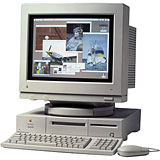 This evolved
into the wider, low profile Centris
610, whose design formed the basis of the Power Mac 6100. Like the IIsi,
both have a PDS and can use a single NuBus card with an appropriate
adapter. Unlike the IIsi, these had room for a CD-ROM drive, which is
why they are wider.
This evolved
into the wider, low profile Centris
610, whose design formed the basis of the Power Mac 6100. Like the IIsi,
both have a PDS and can use a single NuBus card with an appropriate
adapter. Unlike the IIsi, these had room for a CD-ROM drive, which is
why they are wider.
Apple merged the low-end and midrange consumer lines in the Peforma 6360 - and made it even more flexible with the Performa 6400 and Power Mac 6500, its 2-slot consumer minitowers. And that was the end of that.
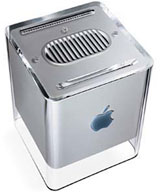 Slotless
Consumer Desktop Macs
Slotless
Consumer Desktop Macs
The modular consumer desktop pretty much disappeared after the 6500 was discontinued in 1998. One could argue that the Power Mac G4 Cube (July 2000) tried to fill that niche, but it was a bust for Apple - and, unlike earlier consumer desktop Macs, its only expansion slot was strictly for video (and it was occupied when you bought the Cube).
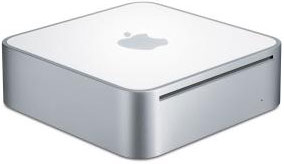 Today the only
modular consumer desktop Mac is even less expandable than the Cube was.
The Mac mini, introduced
in 2004, has no expansion slots whatsoever.
Today the only
modular consumer desktop Mac is even less expandable than the Cube was.
The Mac mini, introduced
in 2004, has no expansion slots whatsoever.
The Portable Legacy
The original Mac was transportable, but it wasn't until the Macintosh Portable was introduced in 1989 that Apple had a fully integrated solution that could be run from battery power. The 16 lb. Portable was no laptop, and Apple entered the notebook market in October 1991 with the PowerBook 100, 140, and 170. Ever since then, Apple has usually had two or more performance options.
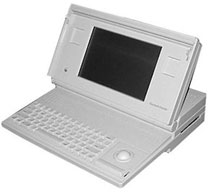
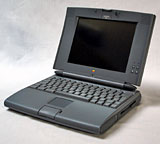
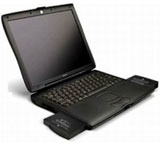
Apple notebooks from the Macintosh Portable through the MacBook
Pro.
On the high-end PowerBooks were Apple's pro notebooks, and their designs morphed from the simple PowerBook 100 series design to the very flexible PowerBook 500 Series, then to the PowerBook 5300, and later to the G3 PowerBooks with drive bays - WallStreet, Lombard, and Pismo. From there, Apple moved the focus to widescreen displays and thin, light designs starting with the first titanium PowerBook G4. Today's MacBook Pro models are the present incarnation of that concept.
 The PowerBook 100 was the
first consumer PowerBook, and its legacy was carried on through the
PowerBook 150, the iBook line, and
today's polycarbonate
MacBooks.
The PowerBook 100 was the
first consumer PowerBook, and its legacy was carried on through the
PowerBook 150, the iBook line, and
today's polycarbonate
MacBooks.
Between the full-fledged pro PowerBooks and the consumer iBooks, Apple created the 12" PowerBook G4. It was small and light - in the tradition of the PowerBook 100, PowerBook Duo models, and PowerBook 2400c. And it was powerful - a step beyond the iBook yet no faster than the entry-level 15" PowerBook. This is the niche the Unibody MacBook fills.
Limited Choices
In the mid 90s, Apple had way too many models. Like GM with its host of brands, Apple had some models that bore the LC, Performa, and Macintosh nameplates. It was downright confusing, and one of the first things Steve Jobs set about doing was simplifying the product line. His goal was to reduce it to four segments: a pro desktop, a consumer desktop, a pro notebook, and a consumer notebook.
The Power Mac and Mac Pro filled the pro desktop quadrant, while the PowerBook and MacBook Pro filled the pro notebook category. The consumer desktop was the iMac, and the consumer notebooks were the iBook and MacBook.
Things are no longer so simple. At times the iMac came in as many as four configurations. G4 PowerBooks came in 12", 15", and 17" models. iBooks came in 12" and 14" sizes. The 12" PowerBook and Unibody MacBook seem to fall between the pro and consumer categories, and the iMac has become a more midrange machine while the Mac mini has become the affordable consumer desktop.
That's not a bad thing. The four-quadrant Mac matrix had its day in the sun. It was a necessary step in eliminating the confusion of too many brands and models. It was never intended as a model for how Apple would always do things.
The iMac continues the Mac's all-in-one desktop legacy, while the Mac Pro fills the pro niche. The MacBook continues the consumer notebook legacy, the MacBook Pro the pro notebook tradition, and the MacBook Air follows in the footsteps of the lightweight PowerBook 100, Duos, and 2400.
The Cube and Mac mini have roots in the original Mac design with a complete lack of expansion slots. They are the headless equivalent of the iMac.
Holes in Apple's Product Line
There is a gaping hole in Apple's product line. Apple has offered all-in-one and modular Macs with standard expansion slots (NuBus, PDS, PCI, etc.) since 1987, but since the death of the Beige G3 ten years ago, Apple hasn't offered a consumer Mac with even a single standard expansion slot. Nothing continues the legacy of the LC, IIsi, Centris 610, Quadra 630, Power Mac 6100, and Performa 6360.
For some time, entry-level Power Macs became more affordable, making them an accessible option for serious Mac users who needed some expandability, but the lowest price a new Power Mac G3 or G4 ever reached was US$1,599, most recently achieved by the entry-level Quicksilver 2002 Power Mac G4. Prices have migrated upward since then, and the least expensive Mac Pro configuration today retails at US$2,199.
There isn't an affordable expandable consumer Mac, a legacy longtime Mac users remember from 1989 through 1998. Steve Jobs emptied that niche and priced the only desktop Mac with expansion slots out of reach for consumers. The Mac Pro is designed and priced for pros, not the rest of us, and the Mac mini doesn't give us the futureproof expandability we long for.
This was a deliberate choice on Apple's part. Apple isn't Dell. It doesn't give us any more choices than it thinks we need. It doesn't believe that we know what we want when we ask for a Mac netbook, a Mac tablet, a MacBook with drive bays, or a consumer desktop with some expansion options.
For all the good Steve Jobs has done for Apple, he has blind spots. The Modbook proves it. The number of netbook users installing Mac OS X proves it. The fact that Psystar could build and market a cheap PC to run Mac OS X proves it.
For a small but significant part of the Mac installed base, Apple doesn't make the Mac we need at a price we can afford, and our only alternatives are to hack OS X onto standard PC hardware, pay a big premium for a Modbook, or continue to work with our legacy Power Macs.*
Apple gives iPod buyers a lot of choices - the very limited shuffle could be considered equivalent to the Mac mini, the nano and classic to the MacBook and iMac, while the iPhone might equate to the Mac Pro.
We have no equivalent of the iPod touch, something with most of the power of the iPhone/Mac Pro that is very flexible but doesn't require a substantial commitment of funds. (The iPhone 3G is only cheap when subsidized with a 2-year contract. Apple sells unlocked iPhones in a few markets, where they retail for the equivalent of $700 to $800. The iPod touch starts at $229 and requires no further commitment of funds.)
I realize that Apple doesn't work like Dell, and I'm grateful for that. However, Apple had a long tradition of providing consumer Macs with at least one expansion slot, and that made these models more flexible and more compelling as they made it possible to expand the computer in ways that Apple may not have anticipated when it designed them.
How about it, Apple? Can we have an affordable midrange Mac with one or two expansion slots?
* This article was written on a 2002 Power Mac G4 expanded with 2 GB of RAM, two USB 2.0 cards, two 400 GB hard drives, a SCSI card, a couple USB hubs, a Dell flat panel display with an integrated USB hub, a pair of cheap speakers, an iPod dock, a second SuperDrive, and Mac OS X 10.4.11 Tiger using Claris HomePage (last updated in 1997) in Classic Mode.
Join us on Facebook, follow us on Twitter or Google+, or subscribe to our RSS news feed
Dan Knight has been using Macs since 1986, sold Macs for several years, supported them for many more years, and has been publishing Low End Mac since April 1997. If you find Dan's articles helpful, please consider making a donation to his tip jar.
Links for the Day
- Mac of the Day: 15" 'TiBook' PowerBook G4, (2001.01.09. A new 1" thin PowerBook design with a titanium case and 15" widescreen display.)
- Support Low End Mac